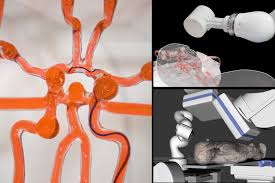AI-Powered Surgical Robot Breakthrough at MIT

Imagine a world where a robot can perform complex heart surgery without a human surgeon guiding it. This isn’t science fiction anymore. MIT has developed an AI-driven surgical robot that recently completed a fully autonomous heart valve replacement, a groundbreaking achievement in medical technology. This milestone could change how surgeries are done, making them safer and more accessible. Let’s explore what this breakthrough means, how it works, and why it matters.
What Is This AI Surgical Robot?
MIT’s new surgical robot uses artificial intelligence to perform heart valve replacement surgery without any human help. Unlike traditional robotic systems, where surgeons control the tools, this robot makes decisions on its own. It uses advanced algorithms, similar to those powering self-driving cars, to navigate the human body with precision. The robot completed its first fully autonomous heart valve replacement in a lab setting, marking a historic moment.
This achievement is exciting because heart valve replacement is a delicate procedure. It involves replacing a damaged heart valve with an artificial one to restore proper blood flow. Doing this without human guidance shows how far AI and robotics have come. My cousin, who’s a nurse, once told me how stressful heart surgeries can be for the team. Knowing a robot could handle such a task with accuracy feels like a glimpse into the future.
How Does the Robot Work?
The robot, developed by MIT’s engineering and medical teams, combines AI with robotic arms equipped with tiny tools and cameras. It’s trained on thousands of surgical videos and patient data to understand human anatomy. The AI processes real-time information, like tissue changes or unexpected bleeding, and adjusts its actions instantly. This adaptability is what makes it different from older robotic systems.
Key Features of the Robot
- Precision Tools: The robot’s arms make tiny, accurate cuts, reducing damage to surrounding tissues.
- 3D Imaging: A high-definition camera provides a clear view of the heart, guiding the robot’s movements.
- Real-Time Learning: The AI adapts to unexpected situations, like irregular heartbeats, without needing human input.
How It Compares to Traditional Surgery
| Aspect | AI Robot Surgery | Traditional Surgery |
|---|---|---|
| Human Involvement | None, fully autonomous | Surgeon controls tools or robot |
| Incision Size | Small, minimally invasive | Larger, often requires open-heart surgery |
| Recovery Time | Faster, less trauma | Slower, more tissue damage |
| Risk of Error | Low, AI-driven precision | Higher, depends on surgeon’s skill |
This technology could reduce human error, which is a big deal. I once read about a patient who faced complications from a small surgical mistake. Knowing AI could minimize such risks gives hope for safer outcomes.
Why Is This Breakthrough Important?
This milestone could transform healthcare, especially for heart patients. Heart valve disease affects millions worldwide, often requiring complex surgery. Many patients, especially in remote areas, lack access to skilled surgeons. An autonomous robot could bridge this gap, performing surgeries in places where specialists are scarce. It also promises faster recovery and fewer complications.
Benefits of Autonomous Surgery
- Accessibility: Robots could bring high-quality surgery to underserved regions.
- Consistency: AI ensures steady performance, unlike humans who may tire.
- Reduced Costs: Over time, robots could lower the cost of complex procedures.
Potential Challenges
- High Initial Cost: Developing and installing these robots is expensive.
- Training Needs: Hospital staff must learn to work with AI systems.
- Ethical Concerns: Some worry about trusting robots for life-saving decisions.
The idea of a robot performing surgery might sound scary. I felt uneasy at first, imagining a machine making life-or-death choices. But after learning how it’s trained on real surgical data, I see it as a tool to support doctors, not replace them. The robot’s success in a controlled lab setting is a big step, but more testing is needed before it’s used on real patients.
What’s Next for AI in Surgery?
MIT’s team plans to refine the robot for real-world use. They’re working on trials with human-like models before moving to actual patients. The goal is to make the robot versatile enough for other surgeries, like coronary bypass or tumor removal. Researchers are also improving the AI to handle even more complex scenarios, such as emergency surgeries.
A recent post on X from a medical tech enthusiast highlighted the excitement: “MIT’s AI robot just nailed a heart valve replacement with zero human help! This could save countless lives.” The buzz shows how people are starting to see the potential. However, experts caution that safety remains the top priority. Rigorous testing will ensure the robot is ready for hospitals.
Future Possibilities
- Expanding to other heart surgeries, like repairing damaged arteries.
- Integrating with wearable devices to monitor patients during surgery.
- Training robots to assist in rural or warzone hospitals.
The road ahead is long, but the potential is huge. I remember visiting a small clinic in a rural area where patients waited months for specialist care. A robot like this could change that, bringing expert-level surgery to those who need it most.
How Does This Compare to Other Advances?
MIT’s robot isn’t the only player in robotic surgery. Systems like the da Vinci Surgical System have been used for years, but they rely on human control. Johns Hopkins University recently developed a robot that performed gallbladder surgery autonomously, showing similar promise. However, MIT’s focus on heart valve replacement, a more complex procedure, sets it apart.
Comparison with Other Systems
| System | MIT’s AI Robot | da Vinci System | Johns Hopkins Robot |
|---|---|---|---|
| Autonomy Level | Fully autonomous | Human-controlled | Fully autonomous |
| Procedure Type | Heart valve replacement | Various, including heart surgery | Gallbladder removal |
| Complexity | High, delicate heart procedure | Moderate to high | Moderate, simpler organ |
| Current Use | Lab testing | Widely used in hospitals | Lab testing |
MIT’s robot stands out for tackling a high-stakes procedure like heart valve replacement. Its ability to work without human input could make it a game-changer. For more on robotic surgery trends, check out this overview on how robotics is shaping heart care.
What Does This Mean for Patients?
For patients, this breakthrough offers hope. Smaller incisions mean less pain and quicker recovery. My neighbor had heart surgery last year and spent weeks in pain from a large chest incision. A robot making tiny cuts could spare others that struggle. It could also reduce hospital stays, saving money and stress.
However, patients might worry about trusting a robot. Hospitals will need to build trust by showing the robot’s reliability through trials. Clear communication about how the AI works will be key. For instance, explaining that the robot learns from thousands of successful surgeries can ease fears.
Patient Benefits
- Less pain and scarring from smaller incisions.
- Shorter hospital stays, often just a few days.
- Lower risk of infection due to minimally invasive techniques.
To learn more about heart valve disease and treatment options, visit this resource from Johns Hopkins Medicine. It explains how robotic systems are already improving heart care.
Final Thoughts
MIT’s AI-powered surgical robot is a bold step toward the future of medicine. By performing a heart valve replacement without human help, it shows the power of combining AI with robotics. This technology could make surgeries safer, faster, and more accessible, especially for those in need. While challenges like cost and ethical concerns remain, the potential to save lives is undeniable.
As we look ahead, this breakthrough reminds us how innovation can transform lives. I think of my uncle, who avoided heart surgery for years due to fear of complications. Technology like this could give patients confidence and hope. With more testing and refinement, MIT’s robot could soon be a trusted partner in operating rooms worldwide, changing healthcare for the better.





